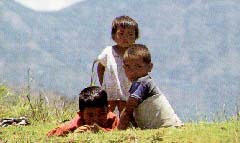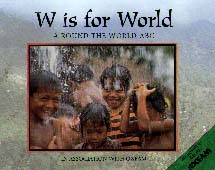|
________________
CM . . . .
Volume V Number 20 . . . . June 4, 1999
excerpt:
 While the ABC book is usually thought of in conjunction with preschoolers
who are just learning the alphabet, the format can also be used with older
children who already know how to read. The intent of W is for World
is to expose North American students to aspects of life largely in less
developed nations of the world. With the exception of "F", which is given
a double page spread, the remainder of the book's pages are each given
over to a single letter. As with "Cc" above, each letter is utilized as a
word within a sentence, and then that word is expanded upon below in a
short text which accompanies a coloured photograph illustrating the word.
While the ABC book is usually thought of in conjunction with preschoolers
who are just learning the alphabet, the format can also be used with older
children who already know how to read. The intent of W is for World
is to expose North American students to aspects of life largely in less
developed nations of the world. With the exception of "F", which is given
a double page spread, the remainder of the book's pages are each given
over to a single letter. As with "Cc" above, each letter is utilized as a
word within a sentence, and then that word is expanded upon below in a
short text which accompanies a coloured photograph illustrating the word.
Although the book was published in association with Oxfam, an international charity, and has the laudable purpose of raising juvenile awareness of life in other parts of the world, especially in third world countries, the work's effectiveness and impact value are questionable. Because the book lacks any continuing "plot," each letter page exists in isolation. "Aa is for Arturo, Alfredo, Agostino and all of the children who work" is accompanied by a photo of five well dressed, smiling boys and the caption, "All over the world, there are children who work. The money they earn helps their families survive. Arturo and his friends are selling samosas, hot spicy snacks on a street in Maputo, Mozambique." Now, if the purpose of this page was to sensitize Canadian children to the fact that child labor exists in other countries, then the text and photograph on the "Aa" page fail to communicate that point adequately. Additionally, in many of the photographs, the people illustrated are adults, not children, and consequently reader identification will be reduced. In some instances, there is not a good match between text and illustration. For example, in "Qq," readers are told, "These women are queuing for water in a village in India," and yet not one of the women is carrying a vessel to hold water. Possibly, teachers could use selected pages to support points they are making in social studies classes. Recommended with Reservations. Dave Jenkinson teaches courses in children's and YA literature at the Faculty of Education, the University of Manitoba.
To comment on this title or this review, send mail to cm@umanitoba.ca.
Copyright © the Manitoba Library Association.
Reproduction for personal use is permitted only if this copyright notice
is maintained. Any other reproduction is prohibited without
permission.
Published by
TABLE OF CONTENTS FOR THIS ISSUE - JUNE 4,
1999.
AUTHORS |
TITLES |
MEDIA REVIEWS |
PROFILES |
BACK ISSUES |
SEARCH |
CMARCHIVE |
HOME
|

